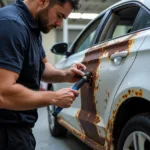At-home car body repairs can be a cost-effective way to address minor cosmetic damage. This guide will equip you with the knowledge and steps needed to tackle these repairs yourself, saving you money and giving you a sense of accomplishment. car body repairs at home
Assessing the Damage: Know Your Limits
Before diving into at-home car body repairs, it’s crucial to honestly assess the damage. Minor scratches, small dents, and chipped paint are often manageable for DIY enthusiasts. However, significant structural damage, deep rust, or damage affecting safety features necessitate professional intervention. Knowing your limits ensures a safe and effective repair process.
What constitutes minor damage? Think surface imperfections that don’t compromise the car’s structural integrity. If you can easily push a dent out from the inside, it’s likely a good candidate for DIY repair. However, if the metal is creased or torn, it’s best to consult a professional.
Gathering Your Supplies: The Right Tools for the Job
Having the right tools is essential for successful at-home car body repairs. Basic supplies include sandpaper, body filler, primer, paint that matches your car’s color, clear coat, masking tape, and various applicators. You’ll also need safety equipment like gloves and a respirator.
Investing in quality materials can make a significant difference in the final outcome. Cheaper alternatives might seem appealing, but they can compromise the durability and appearance of the repair.
Step-by-Step Guide to At-Home Car Body Repairs
Let’s break down the typical process for minor dent repair:
- Clean the Area: Thoroughly clean the damaged area with soap and water to remove any dirt or debris.
- Sand the Damaged Area: Use sandpaper to smooth out any rough edges and prepare the surface for body filler.
- Apply Body Filler: Apply body filler to the dent, following the manufacturer’s instructions.
- Sand the Filler: Once the filler dries, sand it down until it’s flush with the surrounding area.
- Prime the Area: Apply primer to the repaired area to create a smooth surface for painting.
- Paint and Clear Coat: Apply several thin coats of paint, followed by a clear coat to protect the finish.
Remember, patience is key. Allow each layer to dry completely before applying the next. Rushing the process can lead to imperfections.
Can I Repair Rust at Home?
Surface rust can often be addressed with at-home car body repairs. This involves sanding away the rust, applying a rust converter, and then priming and painting the affected area. car body paint repairs at home dorset However, if the rust has penetrated deep into the metal, professional repair is necessary.
“Rust is like a cavity,” says automotive expert, David Miller. “Ignoring it will only make the problem worse. Addressing surface rust promptly can prevent it from spreading and causing further damage.”
Matching Your Car’s Paint Color
Finding the exact paint color for your car is crucial. Your car’s paint code can usually be found on a sticker inside the driver’s side doorjamb or in the owner’s manual. car body repairs at home romford Using the correct paint code ensures a seamless and professional-looking repair.
At-Home Car Body Repairs vs. Professional Repair
While at-home car body repairs are suitable for minor damage, professional repair is always recommended for significant damage. Professionals have the expertise, tools, and experience to handle complex repairs and ensure the structural integrity of your vehicle. car body repairs at home epsom sutton When safety is a concern, it’s never worth the risk to attempt DIY repairs.
Conclusion
At-home car body repairs can be a rewarding and cost-effective solution for minor cosmetic issues. By following the proper steps and using the right tools, you can achieve professional-looking results and restore your car’s appearance. Remember to always assess the damage realistically and seek professional help when needed.
FAQs
- Can I repair a cracked bumper at home? Small cracks can sometimes be repaired with specialized epoxy, but larger cracks or damage affecting the bumper’s structural integrity require replacement.
- What type of sandpaper should I use for at-home car body repairs? Start with a coarser grit (e.g., 180-grit) for initial sanding and gradually move to finer grits (e.g., 320-grit) for smoothing.
- How long does it take for body filler to dry? Drying times vary depending on the product and environmental conditions, but it typically takes between 30 minutes to an hour.
- Do I need to use a clear coat after painting? Yes, a clear coat protects the paint from UV rays, scratches, and other environmental factors.
- Can I use spray paint for at-home car body repairs? Yes, spray paint is a common choice for DIY car body repairs, but ensure it’s specifically designed for automotive use. car body repairs barnstaple at home
- How do I remove scratches from my car at home? Minor scratches can be removed with a rubbing compound or scratch remover product. Deeper scratches may require sanding, priming, and repainting.
- What should I do if I accidentally damage the paint while repairing a dent? If you accidentally damage the paint, you may need to sand the affected area, prime, and repaint.
Need help with your car repairs? Contact us via WhatsApp: +1(641)206-8880, or Email: [email protected]. Our customer service team is available 24/7.



